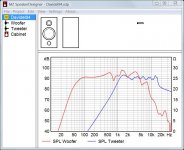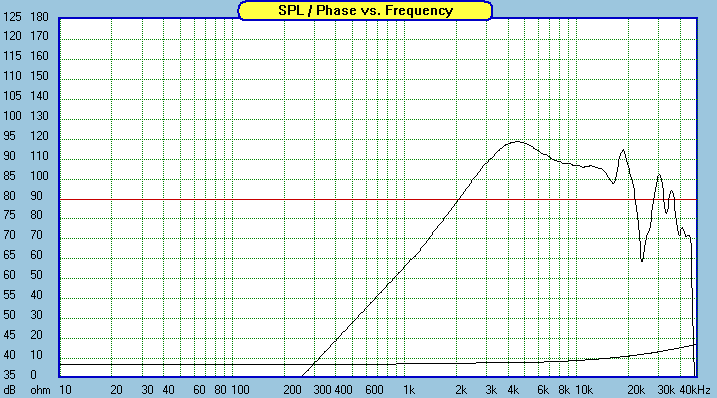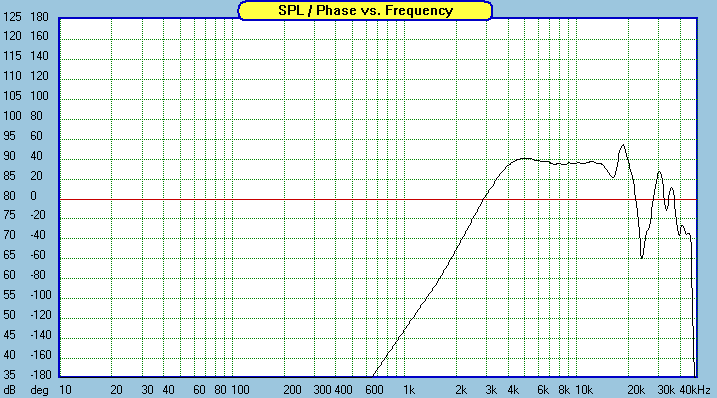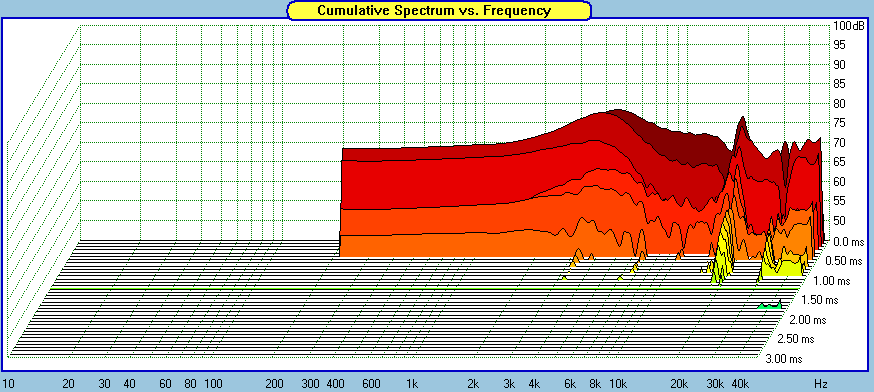A Qts of 0.55 is the upper limit for bass reflex, but it works. The volume is now 25-30 litres, I hope that's not too large for you. I made a simulation of the drivers in a box of 26 litres. The port is 60 mm diameter and 50 mm length. For the woofer I assumed a Qts of 0.55 and a frequency response of a comparable driver. The simulation is without crossover, just to give you an impression of what you may expect...


I you have the money and time to use twice the amount of amp's and active x-over.
Then I really cant see the point in using such cheap and bad spec drivers - sorry to say.
But what is your reason to use these, when so much better gear is available for a little bit more money?
Just asking
Then I really cant see the point in using such cheap and bad spec drivers - sorry to say.
But what is your reason to use these, when so much better gear is available for a little bit more money?
Just asking
A little bit of respect for fellow forum members wouldn't go astray you know...Hi,
You are so wrong regarding cheap tweeter design it is untrue.
Cheap tweeters have high Fs and moderate high Q such that
a single series capacitor yields a usable 3rd order roll off.
I'm peed off that i even have to explain this :
And this sort of design approach is exactly why so many speakers these days sound like garbage. Sure, the single cap is a good match as far as the final transfer function goes, (flatish response with a 3rd order acoustic roll off) but it won't sound any good because the tweeter is going to be driven right through its resonance and also over driven with low frequencies. (excursion will only decrease by 6dB/oct below the mechanical resonance)e.g. a cheap tweeter around 4KHz Fs ferrofuild damped :

The same with a series capacitor :

a flat 3rd order roll off you can work with.
With a tweeter its not just the final acoustic transfer function that matters, the electrical transfer function matters a great deal as well, since tweeters are relatively speaking fairly fragile and don't sound good when driven with too much LF, well before they actually spit the dummy and burn out.
If you're making the most of a bad situation (trying to get the best result from a $2 tweeter with an equally cheap crossover) then so be it, but an example of good design practice in general it is not. I'm with tvrgeek in that for a quality design the tweeter should be crossed over an octave above its resonance so that the electrical filter (2nd order minimum) dominates rather than using the mechanical resonance as a major part of the transfer function.
Sure, you can't use a $2 tweeter any more as you'll need a decent one with a low Fs, but you won't be getting $2 sound either...
You must be looking at a different graph to everyone else, the CSD graph clearly shows a massive resonance at about 18Khz.Picking holes in the top end of a $2.50 tweeter is churlish, and its
not break up according to the CSD, Zaph|Audio Ctrl F "nuance"

A dip followed by a peak with a rapid transition between the two is a classic example of cone breakup. Zaph always seems to use a very compressed scale on his graphs which makes things look better than they actually are - the height between the dip at 16Khz and the peak at 18Khz is about 8dB, which is a rather high Q resonance and will be audible as a harsh edge at the top end.
Just from looking at the frequency response we know there must be a resonance there, we don't need to see a CSD to confirm it as the two are two sides of the same coin. There can't be a dip and a narrow spike in the amplitude response without ringing in the time domain...
Last edited:
you said that the box should have a volume of 30 liters but this volume is calculated considering the enclosure as a void box or 30 liters must be the effective volume of air inside, considering the enclosure with the loudspeaker and the port mounted?
instead of a circular port can a make a rectangular port with the same volume of air in it? So here it is 60 mm diameter and 50 mm length so the volume is 141300 squared mm, so if i make a port 100x35 with lenght 40mm volume 140000 squared mm is it still good?
instead of a circular port can a make a rectangular port with the same volume of air in it? So here it is 60 mm diameter and 50 mm length so the volume is 141300 squared mm, so if i make a port 100x35 with lenght 40mm volume 140000 squared mm is it still good?
Don't think I'm sticking up for you Sreten ( you don't need it ) but I do agree that with these cheap drivers a simple sealed box with a single 3.3uF cap in front of the tweeter is going to sound as good as anything done with Bi-Amping. Will it sound good? Probably as good as any of the cheap Japanese speakers we all bought in the 70s and 80s. I have several in the shed in various states of disrepair, and some of them still sound very good. Those with real Coral woofers and open backed tweeters especially.
These are really cheap drivers, best suited to a cheap box and a cheap XO, single cap somewhere around 3.5/5k
These are really cheap drivers, best suited to a cheap box and a cheap XO, single cap somewhere around 3.5/5k
Davidel94:
As the rectangular port has a greater surface than the round one, you will have to make it longer than 40 mm. But 100 x 35 mm is basically ok. The advantage of a round port is, that the length is tuneable, while a rectangular port usually has a fixed length. But first you have to decide on the internal volume of your box, and then you can determine the length of the port.
As we do not know the woofer parameters exactly, there are two possibilities:
1. Use LIMP to measure the driver parameters precisely (including Vas).
2. Try a box of 25-30 liters internal volume and hope it's not completely wrong.
Tweeter discussions:
The Monacor tweeter has a Fs of 1365 Hz and is completely different from what you are talking about. First order passive filtering does not work at all. I fully agree with DBMandrake, a first order filter leads to excessive cone excursions below the crossover frequency and is nothing else than a fundamental mistake in crossover design. But Davidel94's active high-pass filter works very well and will perform much better.
As the rectangular port has a greater surface than the round one, you will have to make it longer than 40 mm. But 100 x 35 mm is basically ok. The advantage of a round port is, that the length is tuneable, while a rectangular port usually has a fixed length. But first you have to decide on the internal volume of your box, and then you can determine the length of the port.
As we do not know the woofer parameters exactly, there are two possibilities:
1. Use LIMP to measure the driver parameters precisely (including Vas).
2. Try a box of 25-30 liters internal volume and hope it's not completely wrong.
Tweeter discussions:
The Monacor tweeter has a Fs of 1365 Hz and is completely different from what you are talking about. First order passive filtering does not work at all. I fully agree with DBMandrake, a first order filter leads to excessive cone excursions below the crossover frequency and is nothing else than a fundamental mistake in crossover design. But Davidel94's active high-pass filter works very well and will perform much better.
I mean the volume of the air inside of the box. Example: The speaker shown in my simulation is 52 x 27 x 27 cm overall. The wall thickness is 19 mm and the internal volume is 25.943 litres.
If 25-30 litres are too large for you, you can also build a 16 liter box and equalize the early roll-off below 100 Hz in the crossover. This is a big advantage of your active crossover and would not be possible in a passive speaker.
If 25-30 litres are too large for you, you can also build a 16 liter box and equalize the early roll-off below 100 Hz in the crossover. This is a big advantage of your active crossover and would not be possible in a passive speaker.
Hi,
Yes they do, as I posted active is a waste of time in this case.
rgds, sreten.
BOLD ABUSE IS NOT AS BAD AS CAPITAL, but italics are best for emphasis.
Delay, steeper cross and the ability to slide the actual xover up and down in frequency to measure and test isnt a waste. You can also notch the Fs and break-up freq of this cheap tweeter. Different impredances and efficiencies are also not an issue. Eq..........this list goes on.
- Status
- This old topic is closed. If you want to reopen this topic, contact a moderator using the "Report Post" button.
- Home
- Loudspeakers
- Multi-Way
- loudspeaker enclosure design